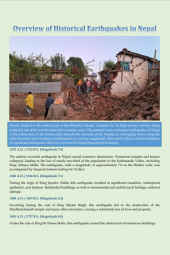Brief History of Earthquakes in Nepal
Summary
Nepal, situated in the central part of the Himalayan Range, contends with heightened seismic activity owing to its location in one of the world's most active seismic zones. The recurrent earthquakes stem from the subduction of the Indian plate beneath the Eurasian plate, generating converging forces along the plate boundary and resulting in earthquakes of varying magnitudes. Spanning centuries, the historical earthquakes in Nepal have left an indelible mark on the region. From the earliest recorded earthquake in 1255 A.D., a devastating event that claimed nearly one-third of the population in the Kathmandu Valley, to the Great Nepal-Bihar earthquake of 1934 that caused widespread destruction and loss of life, these seismic events underscore Nepal's vulnerability to such natural disasters. The enduring impact on structures, cultural heritage, and, most importantly, the lives of its people highlights the need for ongoing efforts to mitigate the consequences of seismic activity in this geologically dynamic region.
Categories:
Article
Publisher:
JP, Nepal
Published Year:
2022
